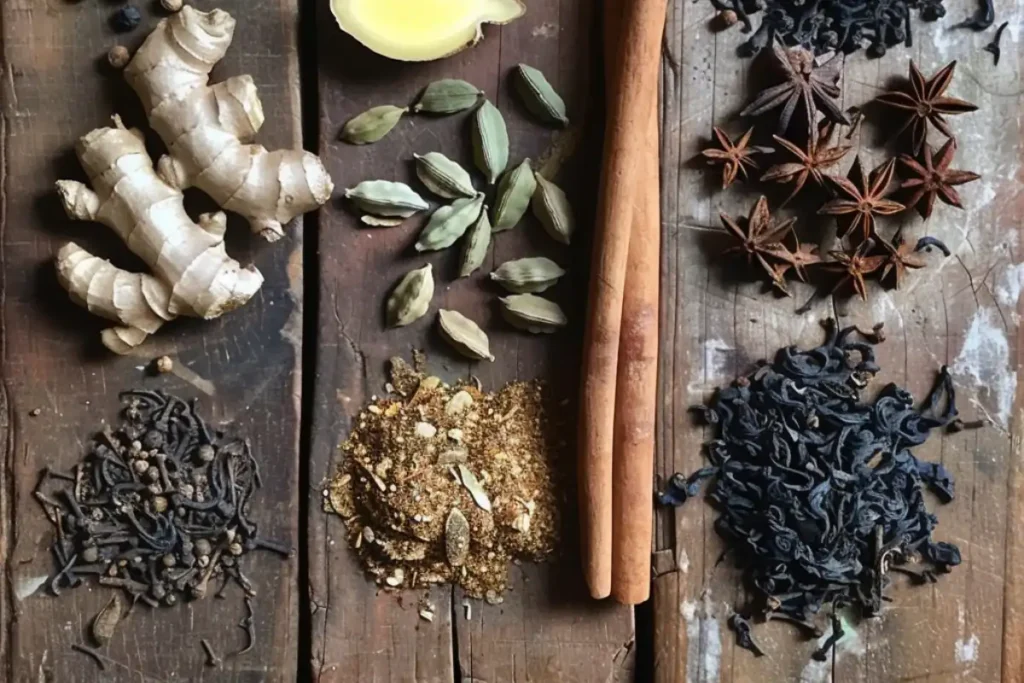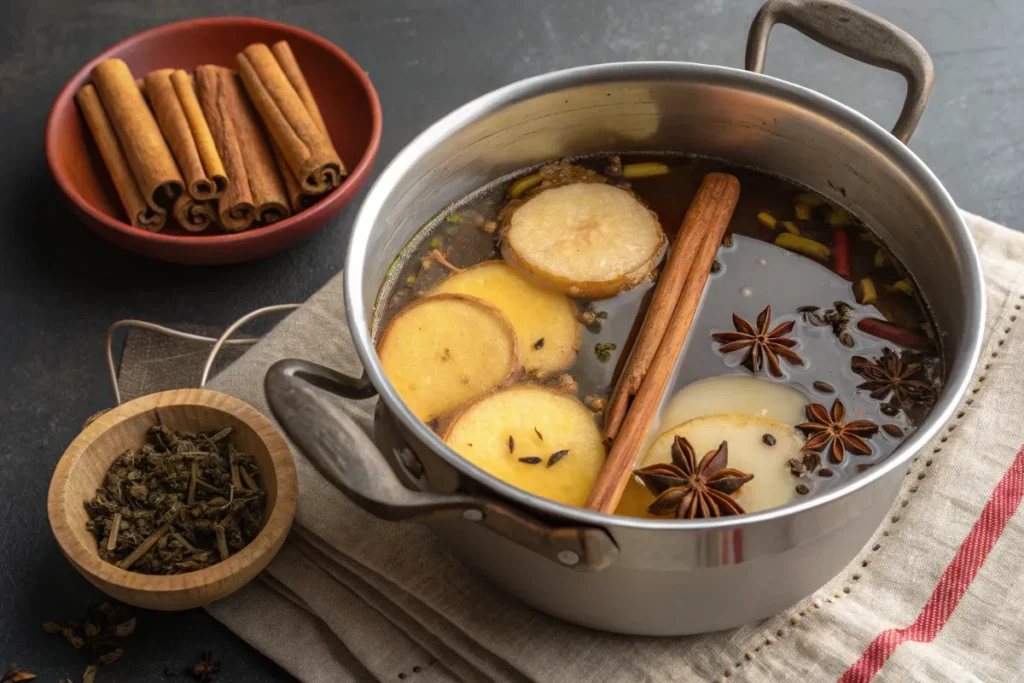Chai is one of the most beloved beverages globally, known for its warming blend of tea and spices. Over the past decade, especially in Western countries, the term spiced chai has also become increasingly popular, leading to some confusion. Are chai and spiced chai the same thing? Is there a fundamental difference between them?
In this article, we’ll explore Chai vs Spiced Chai, breaking down the key differences in ingredients, flavor profiles, and brewing methods. By the end of this article, you’ll have a thorough understanding of the differences and be able to choose which beverage suits your tastes best.
What is Chai? A Timeless Tradition 🌿
In Hindi, chai means “tea,” but in India, it refers to masala chai—a blend of black tea, milk, sugar, and spices like ginger, cardamom, and cinnamon.
More than just a drink, chai is a daily ritual, symbolizing hospitality, warmth, and connection. Every household has its own twist—some prefer extra ginger for spice, while others highlight cardamom’s fragrance
You can read more about the history of chai in India to better understand its cultural significance and journey across the world.
What is Spiced Chai? A Western Twist ☕✨
Spiced chai is a sweeter, creamier adaptation of traditional masala chai, popularized by chai lattes in Western coffee shops.
- Rich & Frothy: Frothed milk enhances the smooth, dessert-like quality.
- Sweeter & Milder: Blends chai tea with extra spices like cinnamon, nutmeg, and vanilla—sometimes even chocolate or caramel.
- Versatile: Enjoy it hot, iced, or as a latte, making it widely appealing.
Chai vs Spiced Chai : Ingredients

When comparing Chai vs Spiced Chai, they may share many ingredients, but their usage and the flavors they emphasize differ significantly
Traditional Chai Ingredients
- Black Tea Leaves: The base of traditional chai is always black tea, usually Assam or Darjeeling. The strong, robust flavors of these teas complement the spices.
- Milk: Whole milk is commonly used to create a rich and creamy texture. In India, people often boil the milk with tea and spices, allowing it to absorb the flavors.
- Spices: The essential spices include ginger, cardamom, cinnamon, cloves, and black pepper. These spices provide a complex and balanced flavor, with each spice bringing its own unique warmth and aroma.
- Sweeteners: Sugar or jaggery is traditionally used to balance the spiciness of the tea. In some households, honey may be used as an alternative sweetener.
Spiced Chai Ingredients
- Black Tea or Herbal Alternatives: Many recipes use black tea, but some versions of spiced chai include rooibos or other herbal teas for a milder flavor.
- Milk or Cream: Prepare spiced chai with steamed milk or cream to enhance its richness.This makes spiced chai lattes popular in cafes.
- Additional Spices: While spiced chai may still include traditional chai spices, the focus is often on cinnamon and nutmeg, with optional additions of vanilla, chocolate, or caramel.
- Sweeteners: Spiced chai is generally much sweeter, often using syrups like vanilla syrup or caramel for an extra layer of flavor.
The key difference lies in the balance of flavors. Traditional chai emphasizes the harmony of spices and tea, while spiced chai tends to highlight sweetness and richness.
For a creative way to incorporate spices similar to those in chai into other culinary adventures, take a look at this recipe for gingerbread latte cookies, which features many of the warming spices found in chai.
Chai vs Spiced Chai : Brewing Methods

Brewing Traditional Chai
In India, people brew chai by allowing the flavors of the spices, tea, and milk to meld together, creating a deeply aromatic and warming beverage. Here’s how to make traditional chai:
- Boil Water: Begin by boiling water with fresh ginger, cinnamon sticks, cardamom pods, and cloves.
- Add Tea Leaves: Once the spices simmer, add black tea leaves and let them steep.Add Milk and Sweetener: Then, pour in whole milk and sugar, and boil the mixture again to blend the flavors.
- Strain and Serve: The final step is straining the tea to remove the spices and tea leaves, resulting in a rich and flavorful drink.
Brewing Spiced Chai
Spiced chai is typically made using a pre-mixed chai concentrate or powdered blend. This makes it easier and faster to prepare but sacrifices some of the depth and complexity of traditional chai. Here’s a quick method for making spiced chai:
- Steam or Heat Milk: Heat your milk or cream, either by steaming it or warming it in a saucepan.
- Add Chai Concentrate: Pour in the spiced chai concentrate or use a powdered mix.
- Optional Sweetener: Many prefer to add an additional sweetener such as vanilla syrup or honey.
- Top with Foam: For a chai latte, top with a frothy layer of steamed milk or whipped cream.
If you want to explore more about chai's history and the variety of spices used, check out Spicy Chai: History, Ingredients, and Recipes.
Flavor Profiles: Chai vs Spiced Chai
Chai Flavor Profile
- Traditional masala chai is bold, spicy, and aromatic. The black tea provides a strong, earthy foundation, while the spices bring warmth and complexity. Ginger and black pepper contribute heat, while cardamom and cinnamon offer sweetness and depth. The flavors of chai evolve with every sip, creating a well-rounded experience.
Spiced Chai Flavor Profile
- Spiced chai, on the other hand, is sweeter and milder. The dominant spices are usually cinnamon and nutmeg, which give the drink a warm, dessert-like quality. Spiced chai lattes, in particular, are known for their creamy, frothy texture and sweet flavor, making them a popular option in coffee shops.
When looking at Chai vs Spiced Chai, the difference in flavor profiles comes down to intensity. Chai is bold and balanced, with spices taking center stage, while spiced chai focuses more on sweetness and richness
Popular Variations :Chai vs Spiced Chai
Chai Variations:
- Dirty Chai: A combination of chai and espresso, offering a caffeine boost while retaining the bold flavors of chai.
- Iced Chai Latte: Perfect for warm weather, this version involves pouring spiced chai over ice and adding cold milk for a refreshing drink.
- Vanilla Chai: A sweeter variation of chai, incorporating vanilla syrup or extract for a more dessert-like experience.
Spiced Chai Variations:
- Pumpkin Spice Chai: A seasonal favorite, blending spiced chai with pumpkin spice flavors to create a comforting fall drink.
- Chocolate Chai: Spiced chai with a hint of chocolate, creating a richer, more indulgent beverage.
- Holiday Spiced Chai: Spiced chai infused with seasonal flavors like peppermint, gingerbread, or eggnog, perfect for the winter holidays.
In the end, the choice of Chai vs Spiced Chai depends on personal preference, whether you enjoy the boldness of traditional chai or the sweetness of spiced chai. If you appreciate bold, complex flavors with deep cultural roots, traditional masala chai is likely your drink of choice. On the other hand, if you prefer something sweeter, creamier, and a bit more dessert-like, spiced chai may be more appealing.
No matter where you stand on the Chai vs Spiced Chai discussion, both are flavorful drinks worth trying. So why not try both and decide for yourself? Pair your chai with a delicious treat like this churro cheesecake for an indulgent tea-time experience.
FAQs: Chai vs Spiced Chai
Is Spiced Chai the Same as a Chai Latte?
- Not exactly. A chai latte refers to chai tea mixed with steamed or frothed milk, while spiced chai can be a broader term referring to chai tea with additional spices like vanilla, nutmeg, or cinnamon.
Can You Make Chai Without Tea?
- Yes! Some versions of chai, especially spiced chai blends, use herbal teas like rooibos instead of black tea. This makes them caffeine-free alternatives for those who prefer to avoid caffeine.
Which is Healthier: Traditional Chai or Spiced Chai?
- Traditional chai uses fresh spices and less sugar, making it a healthier option compared to spiced chai, which often includes added sugars and syrups
Can I Use Non-Dairy Milk in Chai?
- Absolutely! Many people enjoy chai with non-dairy milk alternatives such as almond, oat, or soy milk. These options provide creaminess without the dairy and can complement the spices beautifully.

